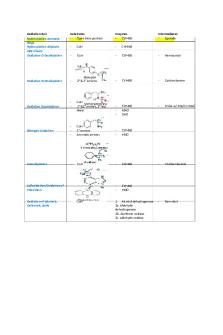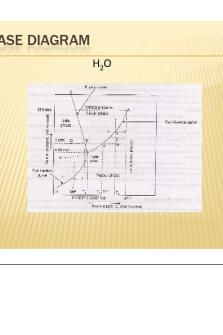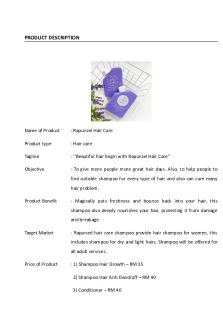Metabolism Phase I and Phase II Reactions PDF

| Title | Metabolism Phase I and Phase II Reactions |
|---|---|
| Author | Student 1107 |
| Course | Cellular and Molecular Basis of Drug Action and Toxicity |
| Institution | University College Cork |
| Pages | 3 |
| File Size | 59.4 KB |
| File Type | |
| Total Downloads | 56 |
| Total Views | 142 |
Summary
Exam question...
Description
Metabolism: Phase I and Phase II Reactions Biotransformation is the enzyme-mediated transformation of compounds both endogenous and exogenous in which lipophilic compounds are converted to more hydrophilic compounds. Biotransformation results in the transformation into more polar metabolite, an increase in molecular weight and size and facilitation in excretion. The consequences of biotransformation include reduced xenobiotic biological half-life, reduces the duration of the exposure to xenobiotics, avoid accumulation of the parent xenobiotic in the organism and changes in the biological activity of the xenobiotic. Phase I of metabolism is the introduction or unmasking of functional groups. If a chemical already possesses a functional group, a phase I reaction is not required. Oxidation is a major phase I reaction. It is mainly catalysed by microsomal, monooxygenase enzymes located in the smooth ER e.g. cytochrome P450 which are FAD containing mono-oxygenases. CYp450 contains iron protoporphyrin as a prosthetic group. It is closely associated with NADPH cytochrome reductase which transfers two electrons to CYP450. CYP450 is a gene superfamily with a collection of isoenzymes, meaning different forms catalyse similar but different reactions. They are categorised by families and subfamilies based on protein sequence homology. Aromatic hydroxylation is an oxidative reaction and the major product is a phenol. For example, phenytoin is an active antiepileptic drugs which undergoes aromatic hydroxylation via CYP450 resulting in inactive 4-hydroxyphenytoin. However, aromatic hydroxylation may involve formation of epoxides which are reactive intermediates. The formation of epoxides are implicated in toxicity. Phenytoin can be metabolised to the reactive metabolite phenytoin epoxide which causes liver and skin toxicity. Aromatic hydroxylation also results in catechols and quinols formation following a second reaction. Oxidative dealkylation involves the removal of alkyl groups from nitrogen, oxygen and sulphur atoms via hydroxy alkyl-intermediate. The alkyl group is converted to the corresponding aldehyde or ketone. N-dealkylation is the most common reaction. Active diazepam undergoes P450 oxidation resulting in active nordiazepam. The N-oxidation of paracetamol results in the reactive metabolite, N-acetyl-p-benzoquinone imine which causes liver toxicity. Oxidative dehalogenation is the removal of halogen atoms which are generally tightly bound from a compound. Halogenated compounds are generally poorly metabolised. A local anesthetic, halothane is metabolised by P450 resulting in reactive trifluoroacetyl chloride which covalently binds to liver protein. This causes either direct liver toxicity or immunemediated toxicity. Alcohol is predominantly metabolised by the cytosolic enzyme alcohol dehydrogenase to form aldehydes. It requires NAD as a cofactor. Aldehydes are also metabolised by alcohol dehydrogenase. When methanol is metabolised, formaldehyde is formed and further AldDH metabolism results in formic acid formation which causes ocular toxicity. Reduction is mediated by the enzymes, DT-diaphorase, cytochrome P450 and cytochrome
P450 reductase and glutathione associated toxic reaction. Dapsone is used to treat dermatitis herpetiformis, it undergoes P450 reduction resulting in redox cycling of the reactive compounds N-hydroxydapsone and nitrodapsone which causes blood toxicity. Hydrolysis is the chemical metabolism of a compound due to a reaction with water. Esters such as procaine undergo hydrolysis by plasma and tissue esterases to an inactive compound. Amides are hydrolysed by CYP450m for example lidocaine. Heroin rapidly undergoes esterase hydrolysis resulting in the active metabolite 6-monoacetylmorphine (MAM) which is more potent than morphine. Hydration reactions occur when a compound combines with water. Hydration of epoxides is mediated by the microsomal enzyme, epoxide hydrolase. When water is added to an epoxide via epoxide hydrolase, a dihydrodiol is formed. This is an important detoxification route for a reactive epoxide formed by CYP450. Phase II reactions involve the addition of endogenous groups to chemicals or its metabolites. Endogenous groups are generally more polar, readily available and bind to functional groups, chemicals or its metabolites. It renders the molecule more polar and less lipophilic. It involves the formation of high energy intermediates. The reactions are mainly cytosolic. Water soluble compounds are more readily excreted than lipophilic compounds. Log P is the logarithm of the partition coefficient for n-octanol/water. A log P value >> 0 means the compound is more lipid soluble while a log P value...
Similar Free PDFs

Phase 1 and phase 2 reactions
- 8 Pages

Phase Rule
- 21 Pages

Phase Diagram
- 4 Pages

TRAFO 1 PHASE DAN 3 PHASE
- 13 Pages

Corr TPHill Phase Photochimique
- 4 Pages

PHASE 1: STRATEGIC PLANNING
- 1 Pages

ERD+ Phase 1 database
- 1 Pages

Phase changes worksheet
- 2 Pages

Single phase IM
- 26 Pages

Phase 2 lesson plan
- 105 Pages

Phase Transfer Catalyst
- 4 Pages

Onion mitosis phase web
- 2 Pages

Phase 1 - Thank you
- 28 Pages

three phase System
- 25 Pages
Popular Institutions
- Tinajero National High School - Annex
- Politeknik Caltex Riau
- Yokohama City University
- SGT University
- University of Al-Qadisiyah
- Divine Word College of Vigan
- Techniek College Rotterdam
- Universidade de Santiago
- Universiti Teknologi MARA Cawangan Johor Kampus Pasir Gudang
- Poltekkes Kemenkes Yogyakarta
- Baguio City National High School
- Colegio san marcos
- preparatoria uno
- Centro de Bachillerato Tecnológico Industrial y de Servicios No. 107
- Dalian Maritime University
- Quang Trung Secondary School
- Colegio Tecnológico en Informática
- Corporación Regional de Educación Superior
- Grupo CEDVA
- Dar Al Uloom University
- Centro de Estudios Preuniversitarios de la Universidad Nacional de Ingeniería
- 上智大学
- Aakash International School, Nuna Majara
- San Felipe Neri Catholic School
- Kang Chiao International School - New Taipei City
- Misamis Occidental National High School
- Institución Educativa Escuela Normal Juan Ladrilleros
- Kolehiyo ng Pantukan
- Batanes State College
- Instituto Continental
- Sekolah Menengah Kejuruan Kesehatan Kaltara (Tarakan)
- Colegio de La Inmaculada Concepcion - Cebu

